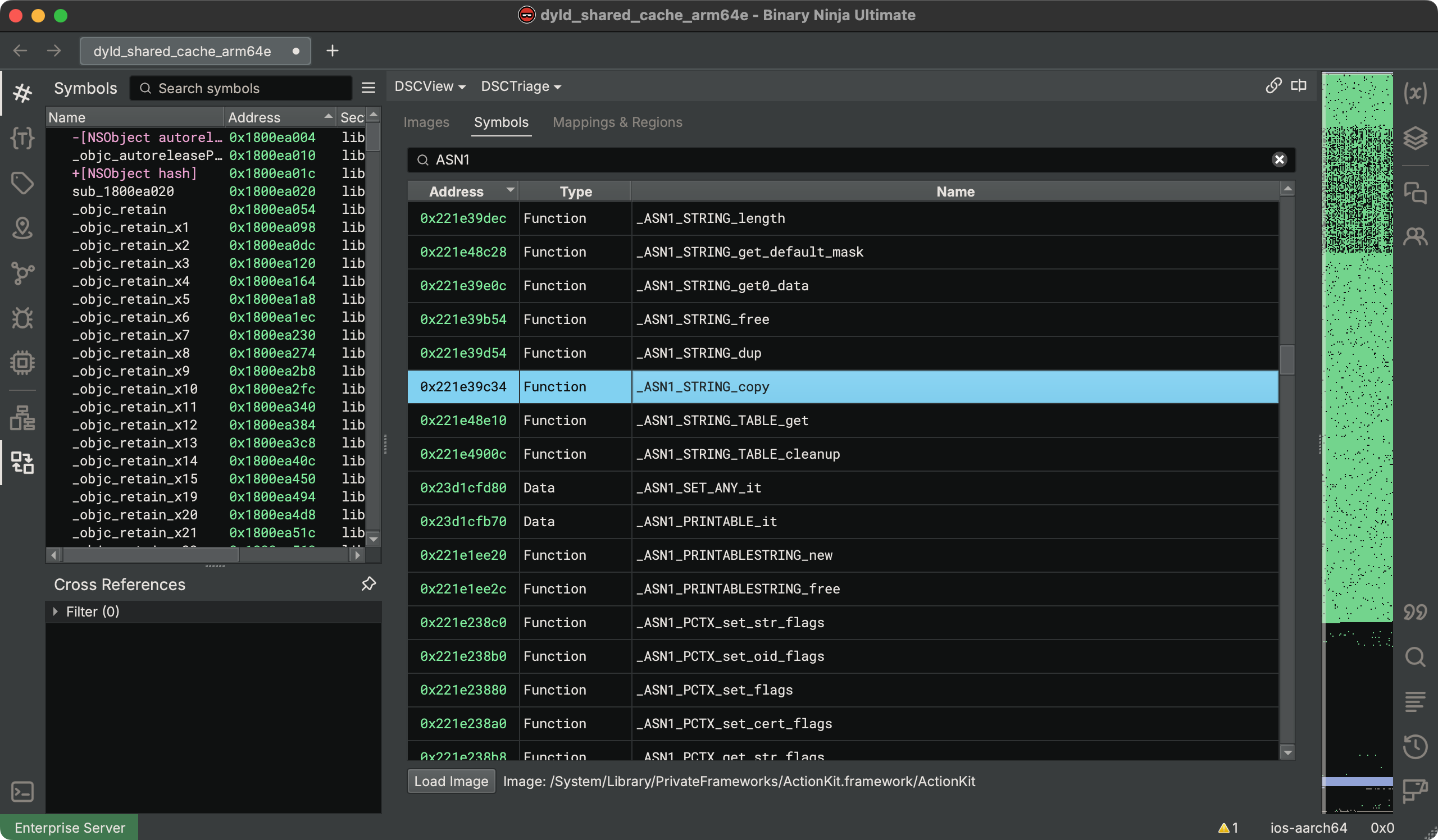Kernel Cache¶
Kernel Cache support in Binary Ninja provides you with tools to selectively load specific images, search for
specific symbols, and follow analysis references between any images loaded from an kernelcache in one view.
Our support for kernelcache is largely open source. The supporting code can be found in our public API repository here. Instructions for setting up your development environment and building plugins like this yourself can be found in our Developer Guide. Contributions are welcome!
Support Matrix¶
List of supported features for the given kernelcache targets:
| Platform | Arch | Versions | Features |
|---|---|---|---|
| macOS | x86_64 | 11 - 26 | Core, Objective-C |
| macOS | arm64 | 11 - 26 | Core, Objective-C |
| iOS | arm64 | 14 - 26 | Core, Objective-C |
- Core: Core functionality, such as loading, navigating, and analyzing
kernelcachefiles. - Objective-C: Support for analyzing Objective-C information and symbols within the
kernelcache.
Note
This plugin currently only supports kernelcache files in the MH_FILESET format.
Obtaining a Kernel Cache¶
The kernelcache is a file that contains all of the kernel and its extensions used by modern Apple operating systems like macOS, iOS, and tvOS. These can be obtained directly from Apple, or with the help of a tool such as blacktop/ipsw.
A kernelcache should typically be automatically decompressed by Binary Ninja. If automatic decompression fails, Binary Ninja can still load
caches decompressed by other tools as long as they are valid MH_FILESET Mach-O files.
Using blacktop/ipsw¶
Our recommended way to retrieve a kernelcache is using blacktop's ipsw tool.
- Install blacktop/ipsw
- Run
ipsw download ipsw --version [target iOS version] --device [target device model (e.g. iPhone10,3)] - Run
ipsw extract --kernel [filename]
Local macOS Install¶
Getting to the local kernelcache on macOS depends on the specific version. Try some of the following:
/System/Library/Kernel/, which should have thekernel, but not necessarily the extensions/System/Library/Extensions/should have each of the individual extensions
/System/Library/PrelinkedKernels/, which should have the fullkernelcache, but may not exist on earlier versions of macOS/System/Library/Caches/com.apple.kernelcaches/, which may be empty/System/Library/Caches/com.apple.kext.caches/Startup/kernelcache/, which may be empty
Interacting With a Kernel Cache¶
After opening a kernelcache, you will be provided a custom binary view. Due to the large size of these files, we do not load all the information into the binary view by default. Instead, this is done on-demand and selectively.
Kernel Cache Triage (KCTriage)¶
The main way to interact with kernel cache information is through the Kernel Cache Triage view (KCTriage). This is the first thing you see when
opening a kernelcache and is how you add images to the actual binary view.
Shows a list of all images within the kernelcache and their virtual addresses.
- Double click on an image to load
- Select image(s) and click button "Load Selected" to load multiple images at once
- Select image(s) and right click if you want more options for loading images
Scripting¶
Another way to interact with the kernel cache information is through the provided Python API, available in the binaryninja.kernelcache module.
# Load the XNU kernel
from binaryninja import kernelcache
kc = kernelcache.KernelCacheController(bv)
image = kc.get_image_with_name('com.apple.kernel')
kc.apply_image(bv, image)
Note
When using the Python console in the UI, the kernel_cache variable is automatically available for the current view.
Note: We do not support single-section loading at this time and can only load entire images.

